V. Painters and the Print
V. Painters and the Print
From the fifteenth to the twentieth century, many leading painters tried their hand in the print media. Albrecht Dürer may be considered one of the greatest Renaissance painters, but he became even more famous as an artist of woodcuts and engravings. Rembrandt has the distinction of being among the most revered painters and print artists of all time. Similarly, while Picasso is recognized first and foremost for his groundbreaking painting, he was also a sculptor, ceramicist, and highly original print artist. Often, painters become noticeably experimental when taking up the print media. In other cases, they appear to have tried to capture the style of their paintings in prints, thereby promoting their achievements in a more accessible medium.
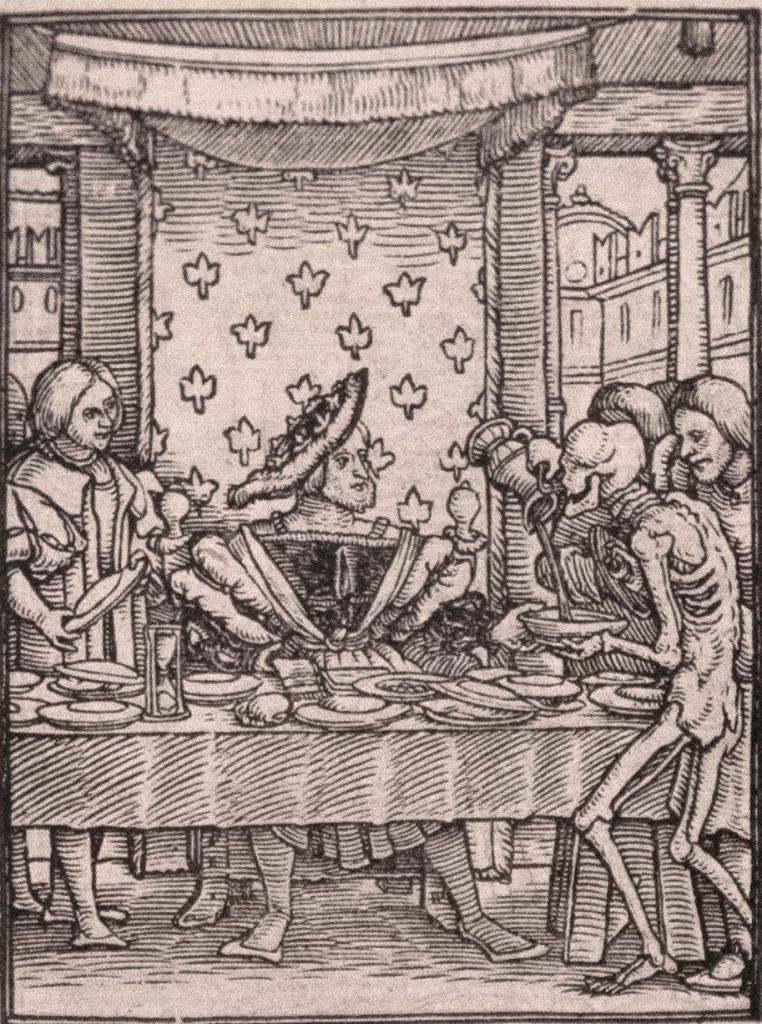
Hans Holbein the Younger (1497-1543)
The King (ca. 1524-1526), from Dance of Death (1538)
Woodcut
2 9/16 × 1 7/8 (6.5 × 4.8 cm)
Collection of Jack May
After immigrating from Switzerland, Hans Holbein became the leading painter at the court of Henry VIII. More than any other source, Holbein’s portraits enable us to see the tumultuous world of Henry’s rule.
Holbein was also a gifted print designer, known for his Dance of Death series and Bible illustrations, including the title page for the first complete Bible ever printed in English (Miles Coverdale’s Bible of 1535). This miniature woodcut portrays Francis I, King of France, being stalked by Death disguised as a lowly servant. Holbein’s woodcut style is distinctive for the ability to express space as well as movement and action so convincingly in a small format.
Recommended Sources
Müller, Christian. Hans Holbein d. J.: Die Druckgraphik im Kupferstichkabinett Basel. Basel: Schwabe, 1997
Nuechterlein, Jeanne. Hans Holbein: The Artist in a Changing World. London: Reaktion Books, 2020
Price, David H. In the Beginning Was the Image: Art and the Reformation Bible. Oxford: Oxford University Press, 2020
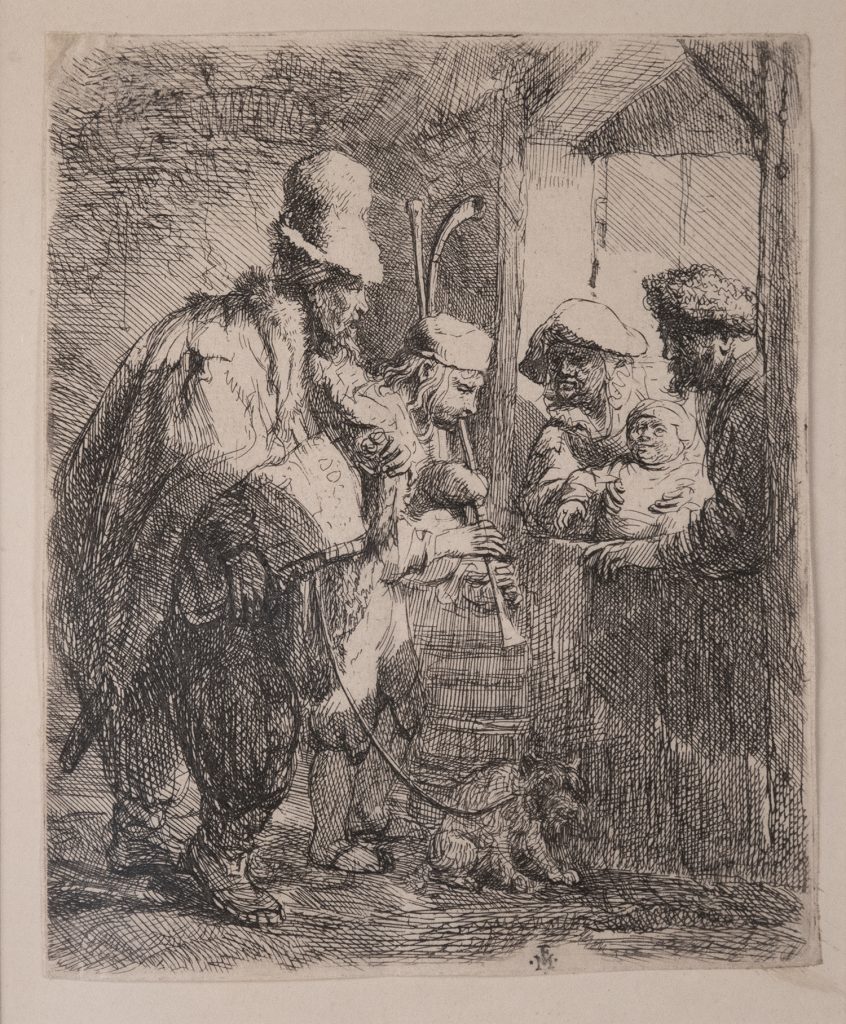
Rembrandt van Rijn (1604-1640)
The Strolling Musicians (1635)
Etching
5 9/16 × 4 13/16 (14.2 × 11.8 cm)
Collection of Jack May
Though renowned for his brilliant paintings, Rembrandt van Rijn was also a bold and experimental printmaker with an extensive oeuvre of nearly three hundred etchings. The Strolling Musicians, one of his many images of everyday life, captures the informal entertainment offered by musicians busking from door to door. One of the musicians, holding his dog on a leash, cranks a crude hurdy-gurdy, while his colleague plays a bagpipe, to the delight of a mother and father with a small child. The two musicians, represented in a dignified profile, bow in a gesture that expresses both their exertions with their instruments and their humble hope for a tip. The five people make thoughtful eye-contact, a display of sympathy with the musicians and recognition of their simple artistry. The most notable stylistic feature, the virtuoso rendering of chiaroscuro (light-dark) contrast, enhances the warmth of the nocturnal scene, a common feature in Rembrandt’s paintings.
Recommended Sources
Silver, Larry. Rembrandt’s Holland. London: Reaktion, 2017
White, Christopher, and Karen G. Boon. Rembrandt’s Etchings: An Illustrated Critical Catalogue. 2 vols. Amsterdam: Van Gendt, 1969
Joseph Mallord William Turner (1775-1851)
Inverary Pier Loch Fyne Morning (1811), from Liber Studiorum (1807-1019)
Mezzotint and etching
8 7/16 × 11 ½ (21.5 × 29.2 cm)
Collection of Jack May
Joseph M. W. Turner remains a canonical artist in the history of landscape painting, admired for his innovative studies of light and color. His landscape and seascape compositions are often monumental and dramatic, qualities that enabled them to compete directly with the prevailing genre of history painting.
This etching is a grand vista of Scotland’s Loch Fyne. Fishermen and boats emerge from a forested backdrop, framed by imposing mountains. The artist expresses a Romantic understanding of the spirituality of nature in the dazzling and perhaps divine radiance of the early morning sun illuminating the scene.
This print was published in Turner’s Liber Studiorum (1807-1819), a comprehensive collection of nearly one hundred examples of Turner’s broad range and innovative approaches to landscape art. The prints, intended to be widely distributed, were loosely categorized into the following genres: historical, mountainous, pastoral, marine, and architectural. Turner’s anthology is modeled after Claude Lorrain’s Liber Veritatis (1777), originally an album of drawings of the artist’s paintings that were subsequently etched and published with great success by an English printmaker.
Turner etched the majority of his prints in outline and collaborated with professional engravers who rendered the rest in the mezzotint. Mezzotint creates strong tonal gradations that emulate a painting; it is achieved by etching a plate after its surface has been roughened using a fine-toothed semi-circular tool called a rocker.
Sarah Treadway
Medicine, Health, and Society and Child Development
Class of 2021
Immersion Project
Recommended Sources
Bockemühl, Michael. Turner. Cologne: Taschen, 2000
Imms, Matthew. “Liber Studiorum: Drawings and Related Works c. 1806-24.” In J. M. W. Turner: Sketchbooks, Drawings and Watercolours, ed. David Blayney Brown. London: Tate Research Publication, 2012
Shanes, Eric. “The True Subject of a Major Late Painting by J. M. W. Turner Identified.” The Burlington Magazine 126 (1984): 284–288

William Blake (1757-1827)
Let the Day Perish Wherein I Was Born, from Book of Job (1826)
Engraving
8 5/8 × 6 3/4 (21.7 × 17 cm)
Collection of Jack May
William Blake has a revered place in the history of poetry, painting, and printmaking as a visionary writer and ground-breaking artist. It comes as no surprise that his oeuvre is distinctive for innovative designs that combined word and image. An accomplished painter in watercolor and tempera, he also advanced the techniques of monotype color printing (achieved by painting directly onto the plate) as well as hand-colored etchings and engravings. This composition, from the Book of Job, is considered one of his masterpieces in pure engraving, although it, too, developed from brilliant preliminary watercolor studies. The struggle of Job with God (and his ultimate reconciliation) lies at the heart of Blake’s mystical exploration of humanity and the divine. One of the intriguing aspects of the portrayal of human suffering is the mirroring of Job’s face in the likeness of God throughout the book.
Recommended Sources
Bindman, David. The Complete Graphic Works of William Blake. London: Thames and Hudson, 1986
Essick, Robert N. William Blake: Printmaker. Princeton: Princeton University Press, 1980
Hults, Linda C. The Print in the Western World. Madison: University of Wisconsin Press, 1996
James A. McNeill Whistler (1834-1903)
Black Lion Wharf (1859)
Etching
11 7/16 × 16 1/8 (29.4 × 41 cm)
Collection of Lynn May
Like Dürer and Rembrandt, Whistler has the distinction of having been a transformative artist both as a painter and a printmaker. In fact, Black Lion Wharf plays a role in Whistler’s career as a painter for he depicted this print as the focal point of his renowned painting Arrangement in Grey and Black No. 1, popularly known as Whistler’s Mother. Additionally, Black Lion Wharf is perhaps the most iconic print from his Thames Set (1871), a collection of sixteen etchings portraying the impressive human activity and natural beauty of London’s famed river.
A cog in the great wheel of England’s global economy, Black Lion Wharf was a bustling dockland, just south of the iconic London Tower Bridge. The juxtaposition of the tranquility of the Thames with abundant commercial productivity idealizes a harmony of nature and London’s booming economy. Imitating the selective focus of the newly invented camera, Whistler directs the viewer’s attention to the warehouses in the background, etching them with great precision. Conversely, he renders the human figures closer to the viewer with hazy detail, perhaps expressing a hint of uncertainty over industrialization. With this technique, Whistler subtly rebukes critics asserting that the advent of photography would be the end of print art.
Peter Stidman
Major: Law, History, & Society
Class of 2023
Immersion Project
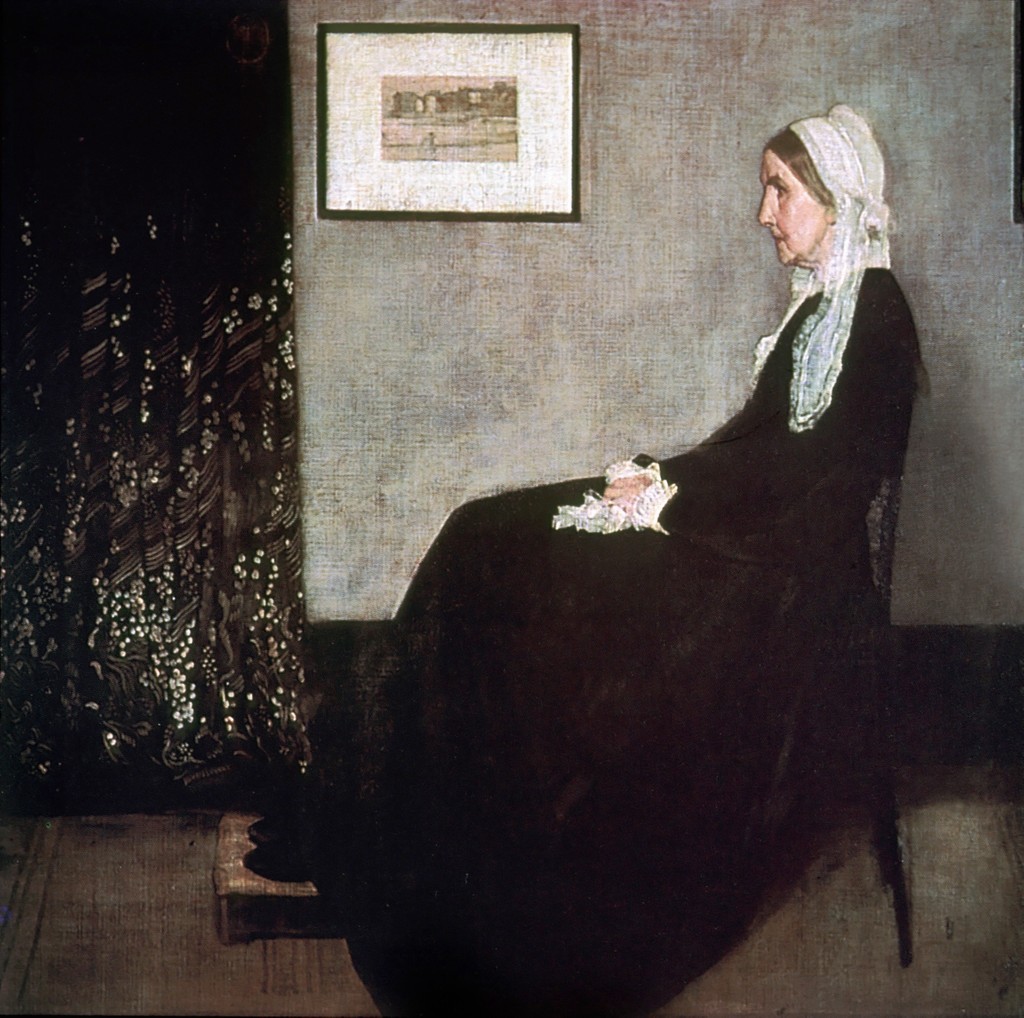
James A. McNeill Whistler (1834-1903), Arrangement in Grey and Black No. 1 (1871). Oil on canvas, 56 4/5 × 63 9/10 (144.3 × 162.4 cm)
Black Lion Wharf hangs elegantly framed just in front of Whistler’s mother.
Recommended Sources
Anderson, Ronald, and Anne Koval. James McNeill Whistler: Beyond the Myth. London: J. Murray, 1994
MacDonald, Margaret F., et al. James McNeill Whistler: The Etchings, A Catalogue Raisonné. Glasgow: University of Glasgow, 2012
Macdonald, Margaret F., and Grischka Petri. James McNeill Whistler: The Paintings, A Catalogue Raisonné. Glasgow: University of Glasgow, 2020
Édouard Manet (1832-1883)
Le Chanteur Espagnol (1861)
Etching
11 7/8 × 9 5/8 (30.2 × 24.5 cm)
Collection of Jack May
Édouard Manet is famed for his pivotal role in modernist painting as both a realist and a harbinger of Impressionism. Although primarily a painter, in the 1860s he also ventured briefly into printmaking, inspired especially by the etchings of Francisco Goya. This etching is a reverse reproduction of his famous painting Le Chanteur Espagnol, which was one of Manet’s first critical successes. In the composition, a young man in Franco-Spanish dress gently strums a guitar as he sings. Capturing the musician mid-song, Manet details how the singer’s leg taps to the rhythm, his fingers arrange themselves to create the desired chord, and his eyes invite the audience into the emotion of his song. While the painting is notable for its realist color and deft brushstrokes, the etching depends heavily on cross-hatching to add depth to the singer’s room in addition to recording the dancing light and the musician’s shadow.
Sarah Treadway
Medicine, Health, and Society and Child Development
Class of 2021
Immersion Project

Édouard Manet (1832-1883), Le Chanteur Espagnol (1860). Oil on canvas, 58 × 45 (147.3 × 114.3 cm)
Recommended Sources
Brombert, Beth Archer. Édouard Manet: Rebel in a Frock Coat. Chicago: University of Chicago Press, 1997
Falwell, Beatrice. “Manet, Edouard.” Grove Dictionary of Art (Oxford Art Online)
Harris, Jean C. Édouard Manet, Graphic Works: A Definitive Catalogue Raisonné. New York: Collector’s Editions, 1970
Harris, Jean C. “Prints by Manet.” Bulletin of the Detroit Institute of Art 49 (1970): 47-62
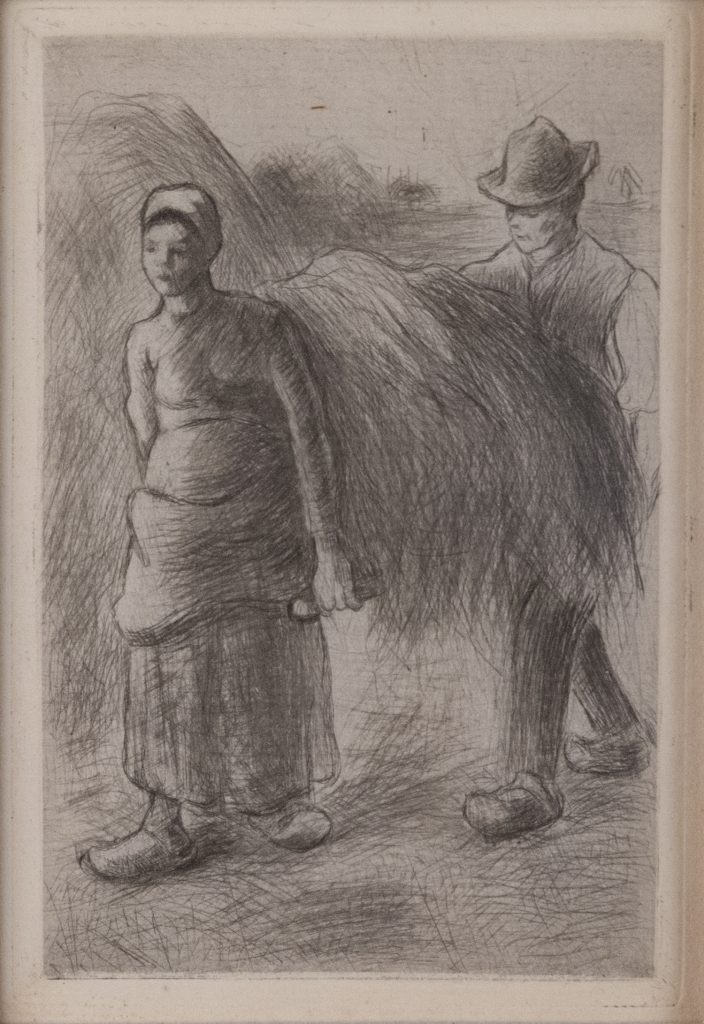
Camille Pissarro (1830-1903)
Peasants Carrying Hay (1900)
Etching and drypoint
5 1/4 × 3 1/4 (13.3 × 8.3 cm)
Collection of Jack May
Inspired by the landscape art of Gustave Courbet and Jean-Baptiste-Camille Corot, Camille Pissarro painted en plein air, a technique in which artists worked their canvases outdoors instead of in their studios. This practice is often credited as being the source of the tranquil beauty of his landscapes. In his late works, Pissarro often represented the working class with deep compassion, an approach associated with the artist’s left-leaning politics.
Though not a painting, Peasants Carrying Hay is typical of Pissarro’s oeuvre. The soft curves and fuzzy hatchings soften the landscape and bestow a gentle dignity on the peasants as they labor. Moreover, these same features create the sensation of motion that epitomizes the Impressionist style that Pissarro introduced to painting.
Chloe Davis
History of Art and Anthropology
Class of 2020
HART 2775: History of Prints
Recommended Sources
Delteil, Loys, Jean Cailac, and Alan Hyman. Camille Pissarro: L’Oeuvre Gravé et Lithographié /The Etchings and Lithographs. Catalogue Raisonné. San Francisco: Alan Wofsy Fine Arts, 1999
Pissarro, Joachim. Camille Pissarro. New York: Abrams, 1993
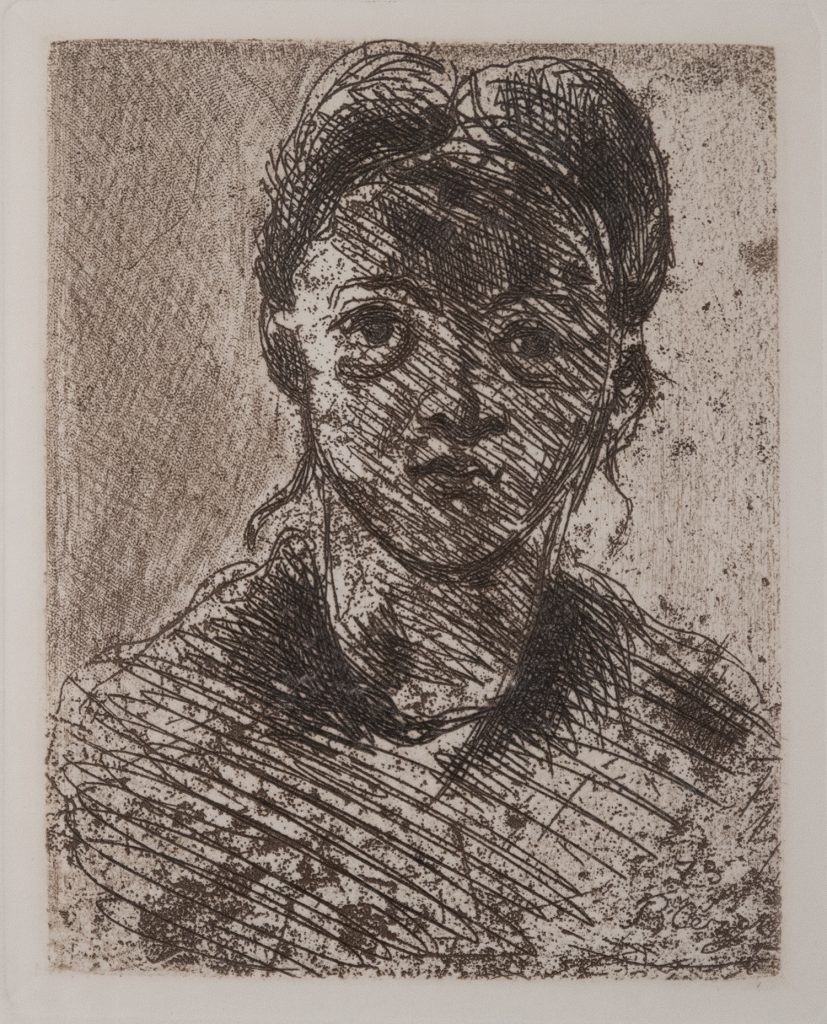
Paul Cézanne (1839-1906)
Head of Young Girl (1873)
Etching
4 7/10 × 3 3/4 (11.9 × 9.5 cm)
Collection of Jack May
Creator of over thirteen hundred paintings, Paul Cézanne was one of the most influential artists in modern European history. At the start of his career, from the early 1860s to early 1870s, Cézanne often painted realistic images of tormented or brooding figures. However, after working with the impressionist Camille Pissarro, he started to incorporate small, thin brush strokes and brighter colors into his work. Eventually, Cézanne developed a distinctive Post-Impressionistic aesthetic that stressed structure and conceptualized objects in accord with a basic geometry of cylinders, spheres, and cones.
Although revered for his pathbreaking painting, Cézanne also dabbled in printmaking, creating compositions that experiment with his eclectic styles, as evident in his early etching Head of Young Girl. With a clearly outlined figure and well-defined facial features, Head of Young Girl is characteristic of the stylized realism of his early career. Simultaneously, the short, layered needle strokes detailing her hair and hazy clothing reflect the growing influence of Impressionism.
Peter Stidman
Law, History, & Society
Class of 2023
Immersion Project
Recommended Sources
Lewis, Mary Tompkins. Paul Cézanne: Painting People. Princeton: Princeton University Press, 2017
Mack, Gerstle. Paul Cézanne. New York: Knopf, 1935
Smith, Paul. Interpreting Cézanne. London: Tate Publishing, 1996
Frederick Childe Hassam (1859-1935)
House on Main Street, East Hampton (1921)
Etching
6 1/8 × 12 3/16 (15.5 × 31 cm)
Collection of Jack May
Childe Hassam had an enormous impact on the development of American Impressionist painting. Like his French models, he favored a palette of brilliant colors, applied with the distinctive broken brush strokes of the Impressionists. He painted atmospheric and picturesque images of coastal and urban scenes. While Hassam adopted many Impressionist techniques, his figures and forms retain their contours and volume rather than dissolving entirely into light and color.
Despite early training as a wood-engraver, Hassam did not attempt printmaking until around 1915, at the age of fifty-five. In the following twenty years, he produced some three hundred fifty etchings and forty lithographs, most of which express the excitement of urban life or the stateliness of colonial architecture around his East Hampton, NY, residence. House on Main Street, East Hampton captures the idyllic charm of home, while exploring the impressionistic qualities of light as it dances on the façade and filters through the trees.
Sarah Treadway
Class of 2021
Medicine, Health, and Society and Child Development
Immersion Project
Recommended Sources
Broun, Elizabeth. “Childe Hassam’s America.” American Art 13 (1999): 33–57
Rosenbaum, Julia B. Visions of Belonging: New England Art and the Making of American Identity. Ithaca: Cornell University Press, 2006
Weinberg, Barbara H. Childe Hassam: American Impressionist. New York: The Metropolitan Museum of Art, 2004
Stuart P. Feld and Kathleen Burnside are currently working on a definitive catalogue raisonné for Hassam.
Pablo Picasso (1881-1973)
Dying Bull Kneeling Before a Dead Woman (1934), plate 7 of the Vollard Suite (1930-1937)
Etching
13 3/8 × 17 11/16 (34 × 44.9 cm)
Collection of Jack May
Although his name is nearly synonymous with Cubist painting, Picasso’s career spans many movements and mediums. His Vollard Suite, a portfolio of 100 etchings, is one of his most extensive explorations of both the print medium and classical style. This etching, Dying Bull Kneeling Before a Dead Woman, recalls the general mytho-erotic stylization of his earlier illustrations for Ovid’s Metamorphoses. In this enigmatic but terrifying image, the emphasis placed on the woman’s supine pose and the bull’s anatomy suggests a pathological sexuality, as do the rearing horse in flight and the disembodied human arms and hands raised in fright. Picasso revisited the subject of bullfighting throughout his career, usually stressing both the grace and violence of the sport. The female bullfighter in particular became a common motif. In this work, the combination of the deceased matadora and the wounded bull creates a sense of stillness amidst the frenzied background.
Chloe Davis
History of Art and Anthropology
Class of 2020
HART 2775: History of Prints
Recommended Sources
Bloch, Georges. Picasso: Catalogue de l’oeuvre gravé et lithographié. 4 vols. Berne, 1968-1979
Gadon, Elinor W. “Picasso and the Minotaur.” India International Centre Quarterly 30 (2003): 20-29
Geiser, Bernard, and Hans Bollinger. Picasso: Fifty-five Years of His Graphic Work. New York: Abrams, 1965





